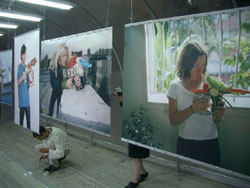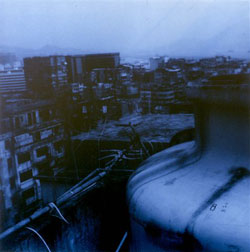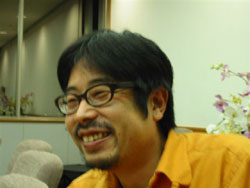Tsuyoshi Ozawa (artist, born 1965 in Tokyo)
Aomi Okabe: Having seen your works so far, I am really interested in the essence of wit which it holds. The large-scale work of Museum of Soy Sauce Art I saw in Ueno was especially overwhelming.
Tsuyoshi Ozawa: I had been elaborating on the idea of the Museum of Soy Sauce Art for about three years. I made it for Fukuoka Asian Museum, The Collection Lambert of Avignon in France, and I made the Sanuki Museum of Soy Sauce Art, which Kameda Soy Sauce Inc. —a soy sauce manufacture in Kagawa prefecture— is permanently exhibiting.
Okabe: What was so interesting was that you actually drew a picture with soy sauce, a peculiar material to Japan and made a parody of the history of Japanese art including the Gutai group and Yayoi Kusama. So you’ve gone through the history. I’d like to hear your opinion about classic such works.
Ozawa: There are paintings that I like and dislike. It’s a process of reviewing both my love and hatred, a feeling towards the history of Japanese art that I can’t sort out. I had to study the whole history by myself, but that gave me a good understanding of it and it was really exciting when I put that together with my own works.
Okabe: How are the Soy Sauce paintings preserved?
Ozawa: I used a special low salt soy sauce that has fungicide added. In Fukuoka Asian Museum, they are taking data to control the temperature and humidity of the space.


Two pieces of Istanbul Biennial venue landscape
© Ota Fine Arts
Okabe: What was most impressing at the exhibition of “Tsuyosi Ozawa & Daisuke Nakayama: CROSS COUNTER” at Taro Okamoto Museum in 2001 was the series of Vegetable Weaponmade by Nitaro Okamoto.
Ozawa: It was one of the ideas for my group exhibition with three fictitious artists called Ichitaro Okamoto, Nitaro Okamoto, and Santaro Okamoto at the Taro Okamoto Museum. I’m thinking to do another solo-group exhibition again.

Kowloon City�@1992�@photo 24.5��24.5����
© Ota Fine Arts
Okabe: When I met you at the Istanbul Biennial in September 2003, you were exhibiting the series of Vegetable Weapon which you produced around the world, in a specially built green house at the Saint Sophia Cathedral, a very popular place for tourists. Now, that was a kind of ‘process art’ that involved finding the special dish of the area, buying the ingredients, asking a woman to model holding the vegetables in the form of a weapon, and taking the picture of her. It also involved the post-production process of eating the dish with everyone who helped. I heard that you decide the model first and discuss with her. So it’s not you but her that went to buy the ingredients.�@
Ozawa: Yes, I asked the models to decide the menu by themselves. It seemed easy for them to understand the process when I showed them a video about it. Some feminists criticized me for making women cook, but actually I also cooked with them because I like cooking. The message contained in this work is something like “You can’t kill anyone with vegetables. So why don’t we eat together and have fun?”
Okabe: Speaking of vegetable assemblages, Giuseppe Arcimboldo, an Italian artist who served Rudolf�U as a court painter in Prague, drew human faces by composing objects like vegetables of the season in such work like the famous The Four Seasons in the 16th century. And in Japan, Kuniyoshi Utagawa in the late edo period did the same in his ukiyo-e.
Ozawa: I love ukiyo-e. Sharaku and everything is great. I don’t have a particular favorite. I try to see various classic artworks from all ages and countries, including Ancient Egypt and the Assyria, without any prejudice such as historical backgrounds.

Tsuyoshi Ozawa�@at Chiba City Museum of Art
photo Aomi Okabe
Student: You have been engaging in what you call Sodan* Art, (*sodan means advice/consultation in Japanese) but I’d like to know what kind of position the people who come to advise have.
Ozawa: In the Sodan Art, I ask people for their advice about how I should make my work. Art can exist by the relation between artists and audiences, but I played with that structure by turning it upside down.
Okabe: At the Nasubi Gallery, you offered the familiar milk box as a small space for solo exhibition for other artists. In a sense of offering a place for creation, I also consider your Tonchiki House where various performance and events are held, as an “Gift Economy Art” (Gift Economy Art is a word to define activities that are similar to the construction of a connected global network by providing free software on the internet) that puts gift giving into practice. You are an expert of this kind since you’ve been doing this for a long time. Is there anything that led you to this sort of activity?
Ozawa: At the panel discussion in a symposium held by the Chiba City Museum of Art, you talked about “Gift Economy Art” which is popular in Asia. When you pointed out that Asia still has a custom of gifts that’s different from that of Europe, I thought that well firstly Asia doesn’t have a place to present one’s artworks. The milk box itself is not a proper place to exhibit, but it ironically illustrates Japan’s situation where such places are lacking. Although the situation is gradually improving, the market isn’t still active enough.
Okabe: But the relation between the works based on “Gift Economy” and the market is a little complicated.
Ozawa: It’s really a headache. Standing between the art for sale and the art I really want to do, I’m always going through trial and error. Maybe I should try to make temporary things remain as something.
Okabe: Surasi Kusolwong from Thailand, the one who fixed a tube to the audience’s nose and sent nice air into it at the Venice Biennale, is also very gift minded. He’s in great demand in many international exhibitions but I can’t help wondering whether he can keep on doing only such service works and how he makes a living.
Ozawa:�@Well, we’re in a very tough situation.
Student: In your book A Guidebook to Tsuyoshi Ozawa’s World, you said during your talk with Takashi Arakawa that “I know the word domestic and global has different meanings. But maybe if we look carefully enough at the domestic, we can see the deep essence of humanity which naturally links with global”. —Should we take this word “domestic” as family or country?
Ozawa: Well, every area differs in appearance, and there are many local realities. But if you focus on it closely, you can find the foundation which is globally mutual. That’s what I meant. Like, if you use soy sauce thoroughly then people will be able to understand it even if they come from a culture which doesn’t use it.
Okabe: I think your works can be more interesting if the audience knows the context of Japan. How is the response from overseas? Are your works appreciated in countries abroad?
Ozawa: I actually don’t know. But I’m not worried at all and I’m just going my own way. In foreign countries, if people cannot understand my works, they just enjoy it with their own interpretation. I stick several concepts together so the work is open to many interpretations. I’m happy if any one of them is understood or, well I really don’t mind if it’s understood in a completely different way from my intention. After all, an artwork is a device that enables many imaginations.
(At Chiba city Museum of Arts, October 12th, 2003, translated by Akihiko Sugiura, revised by Emma Ota)
���@�i�A�[�e�B�X�g�j�@�@�@�@�@�@1965�N�@�������܂�@�����ݏZ
���������݁F����̂��d��������܂Ŕq�����Ă��āA�������̃G�X�v���Ƃ������G�b�Z���X�ɑ�ϋ������Ђ���Ă����̂ł����A�Ƃ��ɏ��Ō����w�ݖ��掑���فx�̑��ɂ͈��|����܂����B
���F�w�ݖ��掑���فx�̃A�C�f�A�͎O�N���炢�l���Ă܂����B�����A�W�A�����فA�t�����X�̃A���B�j�����̃R���N�V���������x�[���A����ƍ��쌧�̏ݖ����[�J�[���c�ݖ�����������ݓW�����Ă���u�]��ݖ��掑���فv�ƁA�O�ٕ�����Ă��܂��B
�����F�������ʔ����̂́A���{���L�̏ݖ��Ƃ����v�f��f�ނɂ��Ď��ۂɊG��`���A���{�̔��p�̓`���ɑ��ăp���f�B�Ƃ��Ă���Ƃ���ł��B���̋�̂Ƃ��A���Ԃ���܂œ����Ă��āA�ߋ����猻��܂ŗ��Ă܂���ˁB�����g�̌Â���i�ɑ���l�����Ȃǂ��������ł�����B
����F�D���ȊG�����邵�匙���Ȃ��̂�����B���{�̔��p�j�ɑ��Ă̈��ł����葞���݂ł�����A���̗����̂ǂ�ǂ낵���悤�Ȃ��́A���̓ǂݒ����Ƃ����Ƃ���ł����ǂˁB�S�������ŕ��������Ȃ��Ă͂Ȃ�Ȃ���������ǁA����ł悭�����Ă��āA�����̐���Ɨ��߂Ă݂���A�������ʔ��������B
�����F�ݖ���̕ۑ��͑��v�Ȃ̂ł����B
����F�ݖ����̂������Ȃ�ł��B�������A�h�J�r�܂������Ă��܂��B�����A�W�A���p�قł́A������ƃf�[�^���Ƃ��ĉ��x�Ǝ��x�Ǘ������Ă��܂��B
�����F2001�N�ɊJ�Â��ꂽ���s���{���Y���p�ق́u�������R�_�C�X�P �N���X�J�E���^�[�v�W�ŁA�����Ƃ���ۂɎc�����̂́A���{�Y��́w��ȕ���x�V���[�Y�ł����B
����F�ŏ��́A���{���Y�̔��p�قŁA���{�ꑾ�Y�A�Y�A�O���Y�Ƃ����O�l�̉ˋ�̃A�[�e�B�X�g���O���[�v�W������Ă���Ƃ����ݒ�ōl������i�ł����B���̎��̂悤�ȃ����}���O���[�v�V���E���܂���낤�Ǝv���Ă��ł���ˁB
�����F2003�N9���ɃC�X�^���u�[���E�r�G���i�[���ł�������Ƃ��A����́A�����Ƃ��ό��q�̑����A�M�A�\�t�B�A���@�ŁA����������Đ��E�e�n�Ő��삵���w�x�W�^�u���E�E�F�|���i��ȕ���j�x�̃V���[�Y��W���Ȃ����Ă܂����B����̓v���Z�X�A�[�g�ŁA�܂��e�n�̖���������T���āA���̍ޗ����A����̌`�ɂȂ�����������������A�ʐ^�ɎB���Ă���A���͂��Ă��ꂽ�݂�Ȃŗ�����H�ׂ�Ƃ����|�X�g�v���_�N�V����������B�������ŗ����̍ޗ����̂ł͂Ȃ��A�ʐ^�̃��f�����Ɍ��߂āA���̐l�Ƒ��k���āA���f���̕����X�[�p�[�Ƃ��ōޗ�����ł��ˁB
����F���������A���j���[�̓��f���Ɍ��߂Ă�����Ă��܂��B���B�f�I��������Ɛ���v���Z�X���킩��₷���݂����ł��ˁB�����ɗ��������ĂƂ��A�t�F�~�j�X�g���猾���邱�Ƃ����邯�ǁA�ڂ��������͍D���Ȃ̂ł����ꏏ�ɍ��܂��B��ł͐l���E���Ȃ��A�݂�Ȉꏏ�Ɋy�����H�ׂ悤�Ƃ������b�Z�[�W������B
�����F��̃A�b�T���u���[�W���ɂ��Č����ƁA�C�^���A�l�Ńv���n�̋{���ƂƂ��čc�郋�h���t2���Ɏd�����W���[�b�y�E�A���`���{���h���A16���I�ɗL���ȁw�l�G�x�Ƃ�������i�ŁA�G�߂̖�Ȃǂ��W�߂Đl�̊�����G��`���Ă܂��ˁB���ƁA���{��������]�ˎ������̍��F�̕����G�Ƃ��B
����F�����G�͂܂������D���Ȃ�ł���ˁB�ʊy�Ƃ��A���ł��D���ł��ˁB���ɒN���ǂ�Ƃ��Ȃ����ǁB���j�w�i�Ȃǂ̕Ό��ɂƂ��ꂸ�A�ߋ��̍�i�͌Í�������킸�A�Ñ�G�W�v�g�Ƃ��A�b�V���A�Ƃ��A���낢�댩��悤�ɐS�����Ă��܂��B
�w���F����́w���k�|�p�x���Ȃ����Ă����ł����ǁA�����ɑ��k�ɂ��邨�q����́A����ɂƂ��ẮA�ǂ������ʒu�Â��ɂȂ��Ă���̂����������ł���B
����F�w���k�|�p�x�ł́A�ڂ������q����ɍ�i���ǂ������炢�������k�����ł��B����Ɗӏ҂������ăA�[�g�͐�������킯�����ǁA���̍\�����t�]������\����̗V�тƂ������B
�����F�w�Ȃ��щ�L�x�ł��A���̍�Ƃɋ������Ƃ�������I�ʼn������������Ȕ����W�̏�Ƃ��Ē��Ă܂��ˁB�܂����܂��܂ȃC�x���g��p�t�H�[�}���X�Ȃǂ��s����u�g���`�L�n�E�X�v�����͈�̏�̑n���ƒƂ����Ӗ��ŁA�����̒����H����u�M�t�g�G�R�m�~�[�n�A�[�g�v�i�C���^�[�l�b�g�Ȃǂɂ����閳���̃\�t�g�̒Ȃǂ��������O���[�o���ȃl�b�g���[�N�̂Ȃ���̍\�z�Ɨގ�����s�ׂƂ��Ē�`�����p��j���Ǝv���Ă��܂��B����͏n���ŁA���Ȃ�O���炱�������s�ׂ��肪���Ă�����Ⴂ�܂����A�ŏ��ɂ��������M�t�g�n�ɓ����Ă������w�i�Ȃ͂���̂ł��傤���B
����F��������������t�s���̃V���|�W�E���̃p�l���ŁA�A�W�A�ɑ����u�M�t�g�n�A�[�g�v�ɂ��Ęb���ꂽ�Ƃ��ɁA�A�W�A�ɂ͐����Ƃ͈Ⴄ���蕨�̏K���╗�K�����ł�����Ǝw�E����Ă��܂������A���̘b���Ďv�����̂́A�܂��A�W�A�ɂ͍�i�\����ꂪ�Ȃ��Ƃ������ƁB���������̂͂�����Ƃ������\�X�y�[�X�ł͂Ȃ����ǁA���ꎩ�̂�����������̂Ȃ����{�̏̔���ɂȂ��Ă��܂��B�������͂悭�Ȃ��Ă邯�ǁA�܂��܂��}�[�P�b�g�����������Ă��Ȃ��ł���ˁB
�����F�������u�M�t�g�G�R�m�~�[�n�v�̍�i�ƃ}�[�P�b�g�Ƃ̊W�͂�����ł���ˁB
����F�����A�����Ă�����������Ă��������ł���B���Ƃ��H�v���āA�c��Ȃ����̂ł��Ȃɂ��`�Ƃ��Ďc��悤�ɓw�͂����Ă��������̂��ȂƂ��B���i�Ƃ��ẴA�[�g�Ǝ����̂�肽�����Ƃ̂������ŏ�Ɏ��s���낵�Ă��܂��B
�����F���Ƃ��A���F�l�`�A�E�r�G���i�[���Ŋϋq�̕@�Ƀ`���[�u�����Ă�����C�𑗂��Ă����^�C�̃X���V�E�N�\���E�H���ɂ��Ă��A�O��I�ɃM�t�g�I�ŁA�����炱����̍��ۓW�ɂЂ��ς肾���ł��A����ȂɃT�[�r�X�������Ă��đ����̂��ȂƁA�����͂ǂ����Ă���̂��ƁA�S�z�ɂȂ�܂��B
����F���肬����E�̂Ƃ���ł���Ă��܂�����ˁB
�w���F�u�����E�̕������v�Ƃ��������̒��ŁA�V��M������Ƃ̑Βk���Ɂu�O���[�o���ƃh���X�e�B�b�N���āA������̈Ӗ��Ȃ��ǂ��A�h���X�e�B�b�N�Ȃ��Ƃ�O��I�ɓ˂��l�߂Ă����ƁA����ɐl�Ԃ̖{���I�Ȑ[�������������Ă��āA�₪�Ă��ꂪ�O���[�o���Ȗ��ɂ����т���Ȃ����v�Ƃ������̂ł����ǁA���̃h���X�e�B�b�N�̈Ӗ��́u�ƒ�v�ł����A�u�����v�ł����B
����F�ǂ��̒n��ł����|���͈Ⴄ���ǃ��[�J���ȃ��A���e�B�͂��ꂼ�ꑶ�݂��Ă��āA����ɂ����ƃt�H�[�J�X�����Ă邱�Ƃɂ���Ă��̐��`�Ƃ����̂��A���ꂪ��C�ɃO���[�o���Ɍq�����Ă����Ƃ����Ӗ��ł��ˁB���Ƃ��A�ݖ���O��I�Ɏg�����ƂŁA������g��Ȃ����̐l�ɂ��������Ă���������̂ł͂Ȃ��낤���Ƃ����W�J�̎d���ł����ˁB
�����F����̍�i�̏ꍇ�A���{�̕����Ȃǂ�m���Ă���Ƃ��y���߂�Ƃ������ʂ�����̂��ȂƎv���̂ł����A�C�O�̔����Ƃ��A���O�ł͂ǂ̂��炢�̗���������̂ł��傤���B
����F�������܂��悭�킩��Ȃ��ł����ǁA���������_�ł͂���Y��ł��Ȃ��āA�����������ƂȂ�����Ă������ł��B�O���ł́A�킩��Ȃ��Ă��A�Ⴄ���߂Ŗʔ������Ă���B�R���Z�v�g���w�O�w�ɂ��Ă��邩��A�����ȉ��߂ɊJ���Ă��āA���̈�ł������Ă����������ȂƎv�����A����Ⴄ�����o�����ł��������ȂƁB�����ȃC�}�W�l�[�V�����������o���鑕�u������B
�i2003�N10��12���A��t�s���p�فA�Q���ҁF��R�ɁA�����ɗC�A�e�[�v�N�����F�����ɗC�j
